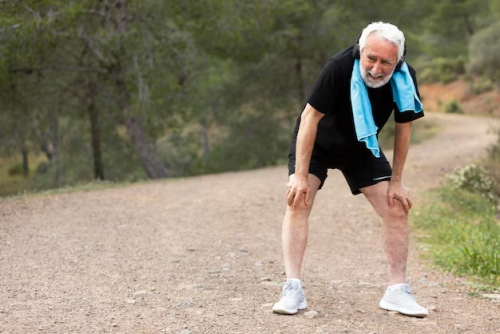Knee arthritis is a common condition that affects millions of people worldwide. It can lead to pain, stiffness, and reduced mobility, making everyday activities challenging. However, incorporating simple exercises into your routine can help alleviate pain, improve joint function, and enhance your overall quality of life. In this blog, we’ll explore effective exercises for knee arthritis relief, along with tips for safe practice and additional strategies for managing symptoms.
Understanding Knee Arthritis
knee exercises for arthritis, primarily osteoarthritis, occurs when the cartilage that cushions the knee joint wears down over time. This can lead to inflammation, pain, and decreased range of motion. Common symptoms include:
Pain during movement or weight-bearing activities
Stiffness, especially after periods of inactivity
Swelling around the knee joint
A grating sensation or sound when moving the knee
While there is no cure for arthritis, engaging in regular exercise can significantly reduce symptoms and improve joint health.
The Benefits of Exercise for Knee Arthritis
Pain Relief: Gentle exercises can help reduce pain by increasing blood flow to the joint and surrounding muscles.
Strengthening Muscles: Strengthening the muscles around the knee provides better support and stability, reducing strain on the joint.
Improved Flexibility: Regular movement can enhance flexibility, making it easier to perform daily activities.
Weight Management: Maintaining a healthy weight reduces the pressure on your knees, alleviating pain.
Enhanced Mood: Exercise releases endorphins, which can help improve mood and reduce feelings of anxiety or depression often associated with chronic pain.
Simple Exercises for Knee Arthritis Relief
1. Heel Slides
How to do it:
Sit on a flat surface with your legs extended in front of you.
Slowly slide your heel toward your buttocks while keeping your foot on the ground.
Hold for a moment, then slide your heel back to the starting position.
Repeat 10-15 times on each leg.
Benefits: Heel slides improve flexibility and range of motion in the knee joint without putting undue stress on it.
2. Straight Leg Raises
How to do it:
Lie on your back with one leg bent at the knee and the other straight.
Slowly raise the straight leg to the height of the bent knee, keeping the knee straight.
Hold for a few seconds, then lower it back down.
Repeat 10-15 times on each leg.
Benefits: This exercise strengthens the quadriceps, the muscles at the front of your thigh, which support the knee.
3. Wall Sits
How to do it:
Stand with your back against a wall and feet shoulder-width apart, about two feet away from the wall.
Slowly slide down the wall into a sitting position, keeping your knees over your ankles.
Hold this position for 10-30 seconds, then slide back up the wall.
Repeat 5-10 times.
Benefits: Wall sits strengthen the quadriceps and improve endurance without putting too much pressure on the knees.
4. Calf Raises
How to do it:
Stand with your feet hip-width apart, using a chair or wall for support if needed.
Slowly lift your heels off the ground, balancing on your toes.
Hold for a moment, then lower your heels back to the ground.
Repeat 10-15 times.
Benefits: Calf raises strengthen the muscles in your lower legs, which can help support your knees.
5. Step-Ups
How to do it:
Stand in front of a step or low platform.
Step up with one foot, bringing the other foot up to meet it.
Step back down and repeat, alternating legs.
Start with 5-10 repetitions on each leg, gradually increasing as you feel comfortable.
Benefits: This exercise mimics everyday movements, helping improve functional strength and stability in the knees.
6. Chair Stands
How to do it:
Sit in a sturdy chair with your feet flat on the ground.
Lean slightly forward and push through your heels to stand up, then sit back down.
Repeat 10-15 times.
Benefits: Chair stands strengthen the muscles needed for sitting and standing, which can enhance overall mobility.
Tips for Safe Exercise
Consult Your Doctor: Before starting any new exercise program, consult your healthcare provider, especially if you have existing health conditions or severe knee pain.
Start Slow: Begin with gentle movements and gradually increase the intensity and duration of your exercises. Listen to your body and avoid pushing through pain.
Focus on Form: Pay attention to your posture and technique. Poor form can lead to injuries and exacerbate existing pain.
Use Support: If necessary, use a chair, wall, or other support to maintain balance during exercises.
Warm Up and Cool Down: Always warm up with gentle movements before exercising and cool down afterward with stretching to maintain flexibility.
Additional Strategies for Managing Knee Arthritis
In addition to regular exercise, consider these strategies to help manage knee arthritis:
Weight Management: Maintaining a healthy weight can significantly reduce stress on your knees. Even small weight loss can lead to noticeable pain relief.
Apply Heat or Cold: Using heat packs can help relax muscles and improve circulation, while cold packs can reduce inflammation and numb pain.
Stay Hydrated: Drinking plenty of water is essential for joint health. Proper hydration can help maintain the viscosity of synovial fluid, which lubricates your joints.
Consider Physical Therapy: A physical therapist can create a customized exercise program tailored to your needs, helping you build strength and improve mobility safely.
Explore Dietary Changes: Some studies suggest that anti-inflammatory diets rich in omega-3 fatty acids, fruits, vegetables, and whole grains may help reduce arthritis symptoms.
Conclusion
Knee arthritis can be a challenging condition, but incorporating simple exercises into your routine can provide significant relief and improve your overall quality of life. By focusing on gentle movements that strengthen the surrounding muscles and improve flexibility, you can alleviate pain and maintain your independence. Remember to consult your healthcare provider before starting any exercise program, and always listen to your body to ensure a safe and effective routine.
With the right approach, you can take control of your knee arthritis and enjoy a more active, fulfilling life. So, lace up your shoes, find a comfortable space, and start incorporating these exercises today! Your knees will thank you.
Business Name - Reed Elite Training | Exercise Specialist Address - 22840 NE 8th Street Unit 106 Sammamish, WA 98074 United States Phone - +1 425-407-3135 Website - https://reedelitetraining.com












